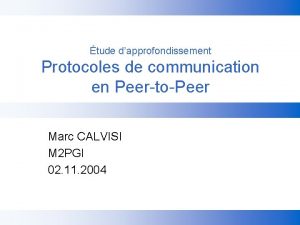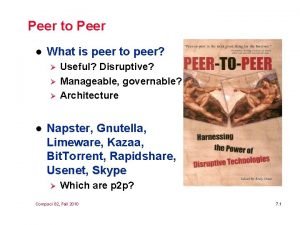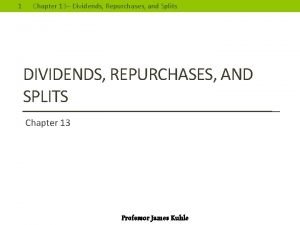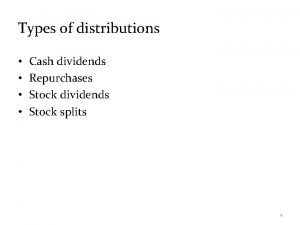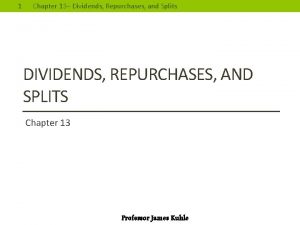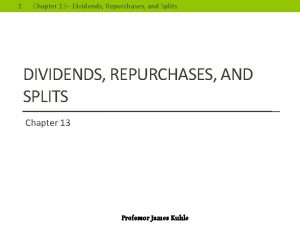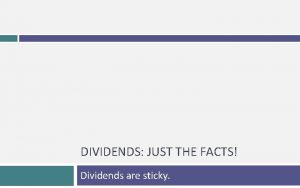DIVIDENDS PEER GROUP ANALYSIS Me too Me too










- Slides: 10

DIVIDENDS: PEER GROUP ANALYSIS Me too, Me too. .


The Peer Group Approach In the peer group approach, you compare your company to similar companies (usually in the same market and sector) to assess whether and if yes, how much to pay in dividends. Company Disney 2013 1. 09% Vale 6. 56% Dividend Yield Average 2008 -12 1. 17% 4. 01% 2013 21. 58% Dividend Payout Average 2008 -12 17. 11% 113. 45% 37. 69% Tata Motors 1. 31% 1. 82% 16. 09% 15. 53% Baidu Deutsche Bank 0. 00% 1. 96% 0. 00% 3. 14% 0. 00% 362. 63% 0. 00% 37. 39% Comparable Group US Entertainment Global Diversified Mining & Iron Ore (Market cap> $1 b) Global Autos (Market Cap> $1 b) Global Online Advertising European Banks Dividend Yield 0. 96% Dividend Payout 22. 51% 3. 07% 316. 32% 2. 13% 27. 00% 0. 09% 1. 96% 8. 66% 79. 32% 3

A closer look at Disney’s peer group 4

Going beyond averages… Looking at the market Regressing dividend yield and payout against expected growth across all US companies in January 2014 yields: PYT = Dividend Payout Ratio = Dividends/Net Income YLD = Dividend Yield = Dividends/Current Price BETA = Beta (Regression or Bottom up) for company EGR = Expected growth rate in earnings over next 5 years (analyst estimates) DCAP = Total Debt / (Total Debt + Market Value of equity) 5

Using the market regression on Disney To illustrate the applicability of the market regression in analyzing the dividend policy of Disney, we estimate the values of the independent variables in the regressions for the firm. Substituting into the regression equations for the dividend payout ratio and dividend yield, we estimate a predicted payout ratio: Beta for Disney (bottom up) = 1. 00 Disney’s expected growth in earnings per share = 14. 73% (analyst estimate) Disney’s market debt to capital ratio = 11. 58% Predicted Payout =. 649 – 0. 296 (1. 00)-. 800 (. 1473) +. 300 (. 1158) =. 2695 Predicted Yield = 0. 0324 –. 0154 (1. 00)-. 038 (. 1473) +. 023 (. 1158) =. 0140 Based on this analysis, Disney with its dividend yield of 1. 09% and a payout ratio of approximately 21. 58% is paying too little in dividends. This analysis, however, fails to factor in the huge stock buybacks made by Disney over the last few years. 6

The problem with changing dividends Investors pick companies based on dividend policy and companies generally pick dividend policies that reflect their characteristics (growth, reinvestment needs etc. ) When a company’s characteristics change, and it needs to change its dividend policy, the clientele may not react well to the change, no matter how well intentioned. 7

Dividend Policy and Clientele a. b. c. d. Assume that you run a phone company, and that you have historically paid large dividends. You are now planning to enter the telecommunications and media markets. Which of the following paths are you most likely to follow? Courageously announce to your stockholders that you plan to cut dividends and invest in the new markets. Continue to pay the dividends that you used to, and defer investment in the new markets. Continue to pay the dividends that you used to, make the investments in the new markets, and issue new stock to cover the shortfall Other 8

Time for a reset on dividends Dividends, as we know them, were designed and structured for equity investments a century ago, when these investments were competing with bonds for investor money. In today’s unpredictable and uncertain world, equity investments in most businesses cannot be viewed as bonds (fixed dividend yield) with price appreciation. Thus, the notion of fixed dividends may have to be abandoned for more flexible dividends, and this may already be happening in the shift to buybacks. 9

Task Relative to the sector in which your company operates, evaluate whether it returns too much or too little cash. 10 Read Chapter 11
 Quantifiers too much too many enough
Quantifiers too much too many enough Annotazioni sulla verifica effettuata peer to peer
Annotazioni sulla verifica effettuata peer to peer Peer-to-peer
Peer-to-peer Peer to peer transactional replication
Peer to peer transactional replication Peer to peer transactional replication
Peer to peer transactional replication Gambar topologi peer to peer
Gambar topologi peer to peer Registro peer to peer compilato
Registro peer to peer compilato Sviluppo condiviso esempi di peer to peer compilati
Sviluppo condiviso esempi di peer to peer compilati Registro peer to peer compilato
Registro peer to peer compilato Peer to peer l
Peer to peer l Peer to peer merupakan jenis jaringan… *
Peer to peer merupakan jenis jaringan… *


